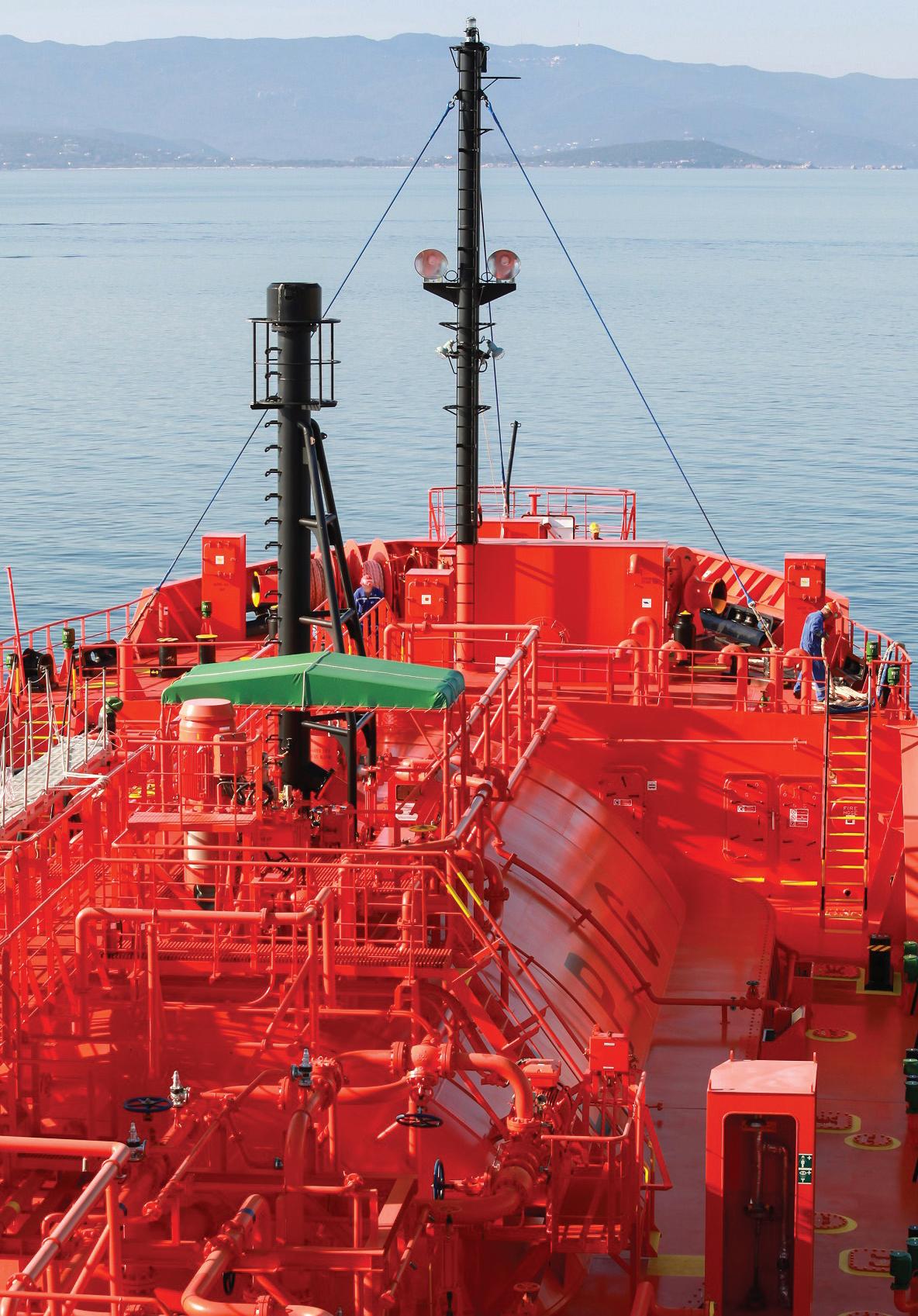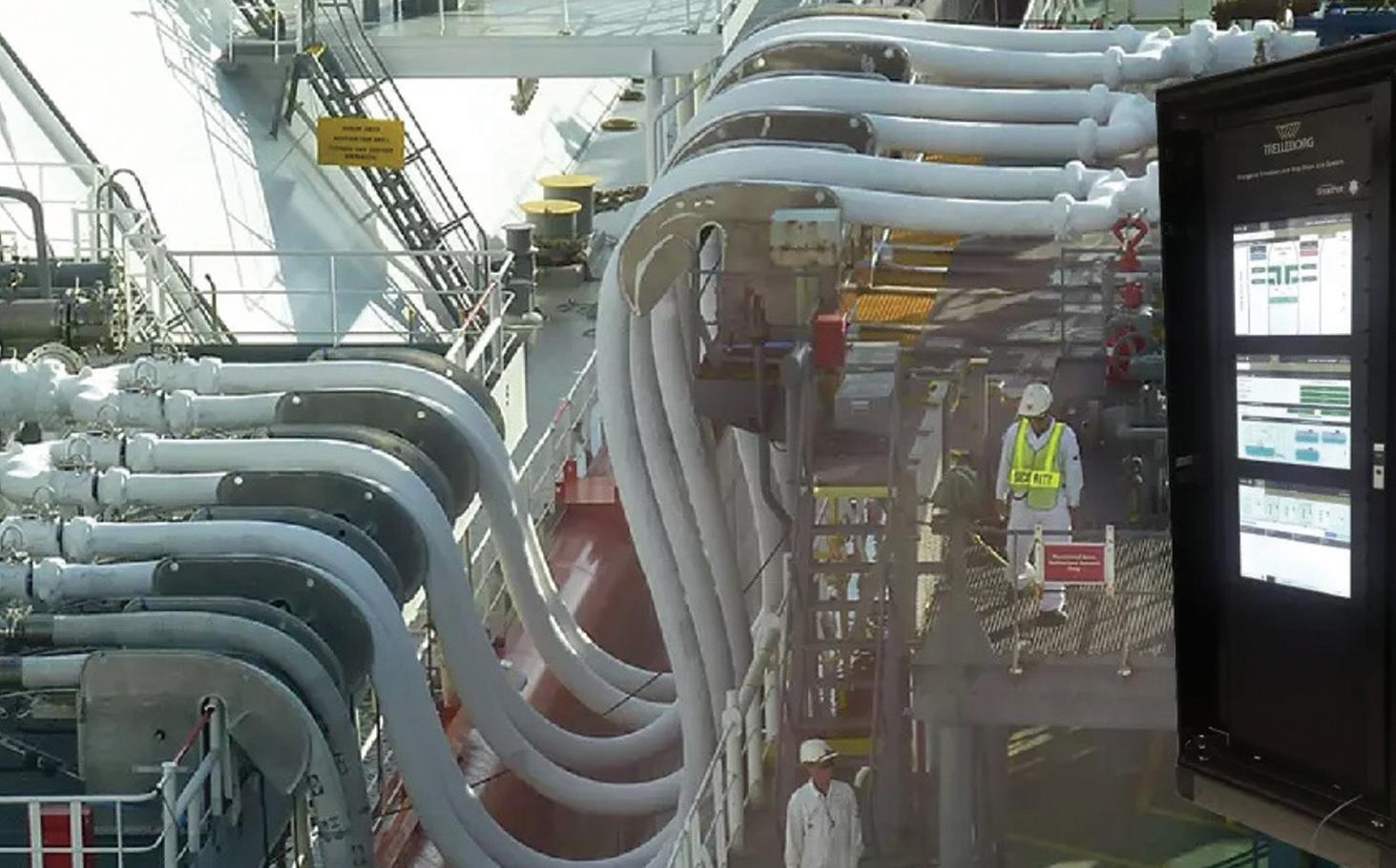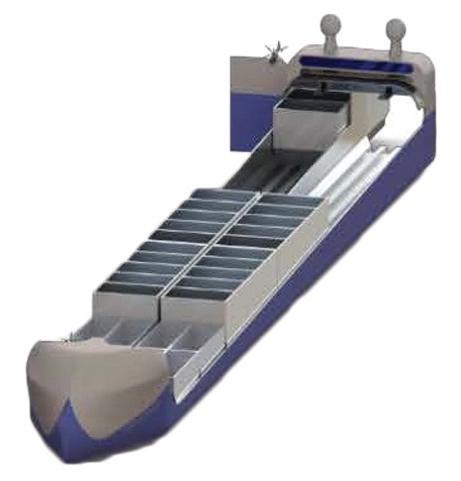
8 minute read
LPG
LOOKING AT THE BUSINESS CASE FOR LPG
Uptake of LPG is increasing because of its greener credentials and simplicity of storage, writes Andrew Stafford, technical director at Trelleborg’s marine and infrastructure operation
Carriage of liquified petroleum gas (LPG) dates back to 1931, when the world’s first custom built gas carrier, the ‘LPG Agnita’, traded parcels of LPG in pressurised tanks. Typically, a by-product of more sought-after products in the oil and gas industry, being able to utilise this asset instead of simply flaring it off, is a benefit not only to the producer but to numerous allied industries, including petro-chem, which use LPGs as part of their dedicated processes.
The composition of the various LPG grades, primarily Butane and Propane, allow not only for simple storage but for efficient transportation and a higher efficiency, cleanerburning hydrocarbon, when compared to coal, wood or oil burning alternatives .
As most LPGs are not identified as greenhouse gasses (GHG), they can be used as propellants and refrigerants, replacing the previous generation of GHG based solutions which are no longer permitted under international law. A caveat to this is the fact that LPG is still a hydrocarbon and once broken down in the atmosphere, will release a CO2 component.
EASY STORAGE
Unlike methane, which requires high pressures to be liquefied and needs to be cooled to be carried, insulated at atmospheric pressure, LPGs become liquid at ambient temperatures and at much lower pressures. This allows them to be stored in either simple pressure vessels or refrigerated containment, making the most of the volume reduction offered in the liquefied state.
This is typically 250:1 reduction in volume between gas and liquid states. The simple tanks required to carry LPG makes them suitable to be stored in bulk at ports, carried in large ocean-going quantities, distributed by road tankers and used by consumers in manageable amounts.
Storing LPG on land side has a number of options. Similar to other process chemicals, custom containment tanks can be built to the LPG. Depending on the volumes that are required to be stored, local tank farms may be used also. Subterranean caverns
8 Sustainability efforts can be further enhanced by incorporating
Ship Performance Monitoring Systems (SPM)

Photo: Trelleborg
are also an option as these allow for vast quantities of gas to be stored within old salt or chalk mines. As the pressure of the stored gas is less than the water table pressure above it, it cannot escape. In some export facilities and due to the simplicity of the liquefaction process, the gas can be liquefied as part of the vessel loading process so no land storage of LPG is required, making this a single process from feed gas, to liquid product and finally vessel loading.
SAFETY
When liquefied, LPG is at or below zero degrees Celsius, it does not require the cryogenic temperature handling of LNG and so the potential of ‘cold-cracking’ a ship deck during a spillage, is removed. However, it remains a flammable substance and as such needs correct handling procedures. An LNG spill will naturally disperse due to methane being lighter than air, however, LPG compounds are typically denser than air and can pool in low level catch points if spilled, requiring active gas dispersion to remove them from an atmosphere.
Under the International Code of the Construction and Equipment of Ships Carrying Liquefied Gases in Bulk (IGC) code, specifically written for the safe transportation of liquefied gasses, all gas-carrying ships should be equipped with an emergency shutdown link enabling a vessel to connect its own safety shutdown equipment to the terminal with which it is trading.
8 Carriage of
liquified petroleum gas (LPG) dates back to 1931
Although LNG developed to include fully connected emergency shut-down (ESD) systems during transfers, LPG transfers were limited to the exchange of a manual shutdown pendant between supplier and receiver. In the event of an emergency being detected, this meant that an individual had to be present to witness the event and push the stop button.
SHIP SHORE LINKS
Trelleborg has been at the forefront of the industry, designing, building and installing industry leading Ship-Shore Links (SSL) with integrated ESD systems for nearly 20 years.
Integrating ESD links during a transfer has recently been highlighted as not only a way to allow safety to be enhanced, but as a mechanism to allow increased flow rates during transfer. The issues of pressure surge, which typically define the maximum flow rate, can be alleviated by having closer monitoring of the entire transfer pipe through active monitoring of the ESD in the system.
Instead of working to a potential of a filling manifold or tank valve closing onto a full flow transfer, linking the ESD means the transfer pump can be stopped as soon as the same signal that instructs the valve to close, is triggered. This reduces the effect of calculated surge by shortening the time between event detection and process stopping.
Such measures can also reduce the likelihood of premature equipment failure by keeping the process equipment within normal operating conditions. Valves and pipework will benefit from reduced surge pressures and there are fiscal benefits to being able to transfer cargo at potentially faster rates, as the surge conditions present in unlinked shutdown events are now mitigated.
Correct utilisation of such measures can allow for more vessels to be loaded and even improve tidal quayside operations, if said vessels can complete loading and leave on an earlier tide.
SUSTAINABILITY FOCUS
As we see an increasing focus on sustainability, more gasses are being used as marine fuels for the first time on non-gas-carrying vessels, aided by the fact that LNG carriers have burnt methane as fuel for many years.
LNG has made a strong push for its place as a marine fuel. However, with new rules allowing other gasses to be used as marine fuels, engine manufacturers are able to provide solutions for the LPG gasses.
The very first LPG-powered gas carriers have recently been delivered, which substantiallyreduce the emissions profile when compared to the traditional fuel mixes. There is scope for smaller vessels, perhaps coastal trade vessels to utilise LPG as a fuel, especially if large volumes are readily available. Even if not used directly, LPG compressorsare used in the liquefaction process of LNG, enabling this greener approach to continue.
LPG MARKET
Sustainability efforts can be further enhanced by incorporating Ship Performance Monitoring Systems (SPM) within operations that allow for improved operational efficiencies onboard vessels, which in turn, can reduce environmental impact.
One of the big shale products to come out of the US as part of their natural gas fracking exploits, is a new source of Ethane,
The composition of the various LPG grades allow not only for simple storage but for efficient transportation and higher efficiency cleaner-burning hydrocarbon

which previously had not been available in such large quantities. Without a market for this gas to be exported to, it would have traditionally been flared to the atmosphere, as there was no benefit in storing it as the domestic supply was already adequate. This opened an entirely new trade route and new fleet of VLGCs utilising atmospheric pressure tanks, similar to liquified natural gas carriers (LNGC), as chilling to liquefy to its boiling point of around -90 degrees celsius is more suitable than compression for bulk transfer.
As a feedstock primarily for ethylene production, markets in India and Europe were interested in gaining access to this new cheap source of ethane. Numerous petro-chem companies invested in the new VLGC concepts, which included options to burn the clean cargo as a fuel, making this not only a commercially viable trade, but also a green trade.
Trelleborg supplied its ESL shutdown links to ethane export berths at a facility in the United States as well as to multiple receiving sites globally to ensure safe transfer of the cargo to the carriers that it loads.
SMART PORTS
As attitudes shift within world shipping towards the importance of incorporating cleaner fuels into its operations, with an increase in popularity in the use of LNG, the Covid-19 pandemic could not have arrived at a more critical point in time.
Industry impacts as a result have meant that demand for LNG has slowed, with buyers cancelling more than 100 US cargoes globally and fuel prices collapsing to record lows in Europe and Asia. Although this has impeded efforts in the short term, there is a positive outlook on the sector emerging more prosperous than before, solidifying the hope that the industry is still serious about change for a better and more sustainable future.
For any business, arguably one of the most important goals of our time is to be able to offer an effective and action-led sustainability plan. It is vital that as an industry, we take steps to become more conscious and sustainable in our decision making. We are continuously exploring ways to further strengthen our portfolio to provide solutions with lower environmental impact.
Trelleborg’s SSL/ESD and SPM systems are part of the SmartPort portfolio, which powers the critical interface between ship and port, on land and at sea. The systems connect port operations, allowing operators to analyse performance and use data to improve decision making.
The system integrates assets like fenders, mooring equipment, ship performance monitoring and navigation systems, underpinned by cloud technologies. Integration of such systems can help port owners/operators in their efforts to support the collective focus areas within the maritime industry towards sustainability.
8 Trelleborg has










